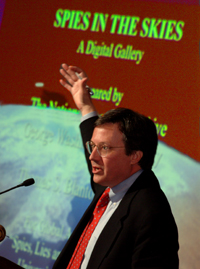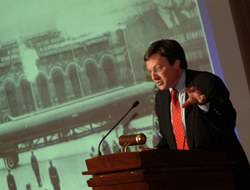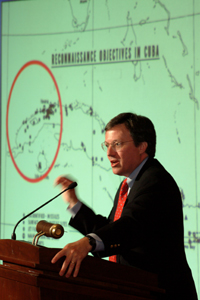 |
| Tom Blanton, director of the National Security Archive at George Washington University |
5:05 p.m., April 24, 2003--Tom Blanton, director of the National Security Archive at George Washington University, presented a digital gallery that captured the historical progress and remarkable impact of spy planes and satellites for U.S. foreign intelligence in his presentation, “Eyes in the Skies,” on Wednesday evening, March 23, in Clayton Hall.
His speech, which was part of UD’s Global Agenda Lecture Series, “Spies, Lies and Sneaky Guys,” also focused on the crucial role aerial photographs played in the 1962 Cuban Missile Crisis. One of the National Security Archive’s main functions is to analyze and explain U.S. decisions during international crises. It has been described by the Los Angeles Times as the “world’s largest nongovernmental library of declassified documents.”
“Aerial photography is a U.S. intelligence capability that really did save the world,” Blanton said. “When enemies each hold nuclear weapons standing at the brink where the push of a button can annihilate the world, then anything that opens them up to each other and makes them understand each other, that impact is enormous. It helps move the finger away from the button.”
Blanton said that before World War I, the cameras used in aerial photography were similar to current professional photographers’ telephoto lenses, forcing planes to fly at low altitudes vulnerable to enemy attack in order to capture effective images. He said 252 pilots and photographers died attempting to take intelligence photographs of Russia, and, out of these. 138 were never recovered.
“The U.S. realized we needed a plane that could fly at 65,000 feet but still be able to take effective pictures. The U-2 was created in response to this, and a new camera was created that could record features from 65,000 feet that were as small as 2.5 feet,” Blanton said.
The new technology set the stage for the United States’ discovery of Russian missiles being transported and stored in Cuba. Blanton presented what he called “the picture that changed the world,” the photograph U.S. intelligence agents used to confirm there were, in fact, Russian missiles in Cuba.
 |
“Everybody asked, ‘Why didn’t the Soviets camouflage this stuff?,’” he said. “[The Russians] were tucking them behind a small Cuban mountain range to the north thinking they were blocking off American photographers from the north in Key West, but the spy planes were overhead capturing it all from above. They saw huge 60-foot objects that looked like big cigars dotting the landscape.”
After intensive research, U.S. intelligence determined that the “cigars” were medium range SS-4 missiles, similar to ones the Russians openly displayed at a May Day parade. Blanton said the intermediate range missiles, if launched from Cuba, could reach not only Washington, D.C., like the medium-range missiles the United States had found evidence of earlier, but as far as Seattle.
“That was the point where they realized it was serious,” he said. At his meeting with Soviet diplomat Andrei Gromyko, Blanton said Kennedy realized these guys were “lying through their teeth.”
Blanton said from this point forward, the United States intensified its aerial photography, focusing more on low-level reconnaissance.
“With low levels you start to see really extraordinary detail in the shots,” he said.
The low-level missions produced photographs with great impact, Blanton said, including a ship that was transporting intermediate launch rings. The rings never arrived in Cuba because of the photographs, he said.
Blanton displayed a photograph of a dilapidated, shot-down U-2 plane to illustrate the transition in aerial photography from planes to satellites. He said that even though U-2s could fly at up to 70,000 feet, technological advances in weaponry rendered them vulnerable to attack.
The Corona satellite, at more than 100 miles above the Earth, took the first photograph from orbit in 1960, but the cameras could only capture those objects in the 25- to 60-foot range. Within a few years, technology had increased the resolution to nine to 25 feet. Currently, satellites that are at 200 to 300 miles altitude can distinguish features that are only 6 inches across on the earth.
 |
“In other words,” Blanton said, “you could tell if a car has a license plate but not what’s written on it.”
One of the most remarkable satellite photographs Blanton presented showed the shadows from a line of people waiting to visit Lenin’s tomb in Russia.
“Photographs with this type of accuracy gave us a sense of security about Russia, as well as other countries,” he said.
Blanton also discussed the current impact of aerial photography. He said cameras are now able to take pictures at night, through cloud cover, and, with the aid of infrared technology, photos of persons inside buildings.
He displayed a 1998 photograph of the Zhawar Kili Al-Badr al Qaeda training camp in Afghanistan where the United States missed killing Osama Bin Ladin by four hours in 1998.
“The U.S. was looking for [Osama Bin Ladin] ever since we found out he was responsible for the attacks on the embassies in East Africa in 1996,” Blanton said. “Clinton decided to attack the camp, but it took seven hours to get the cruise missiles there. Half way through that we have recorded images of a caravan of trucks transporting Osama out of there.
“It’s one of those great ‘what-ifs’ of the world,” he said. “I wonder if the World Trade Centers would still be standing today. I also wonder, what happened between August of 1998 and September of 2001 that we never found him again?”
Blanton is a graduate of Harvard University, where he won the 1979 Newcomen Prize in history. He also received the 1996 American Library Association Citation for “defending the public’s right to know.” In addition to writing and co-authoring many books and articles, Blanton is a founding editorial board member of [freedominfo.org], the virtual network of international freedom of information advocates and serves on the editorial board of H-DIPLO, the diplomatic history electronic bulletin board.
The Global Agenda Lecture Series is presented in association with the World Affairs Council of Wilmington. For more information on upcoming events, visit [www.udel.edu/global] or call 831-2355.
Article by Amie Voith, AS 2003
Photos by Eric Crossan
|

